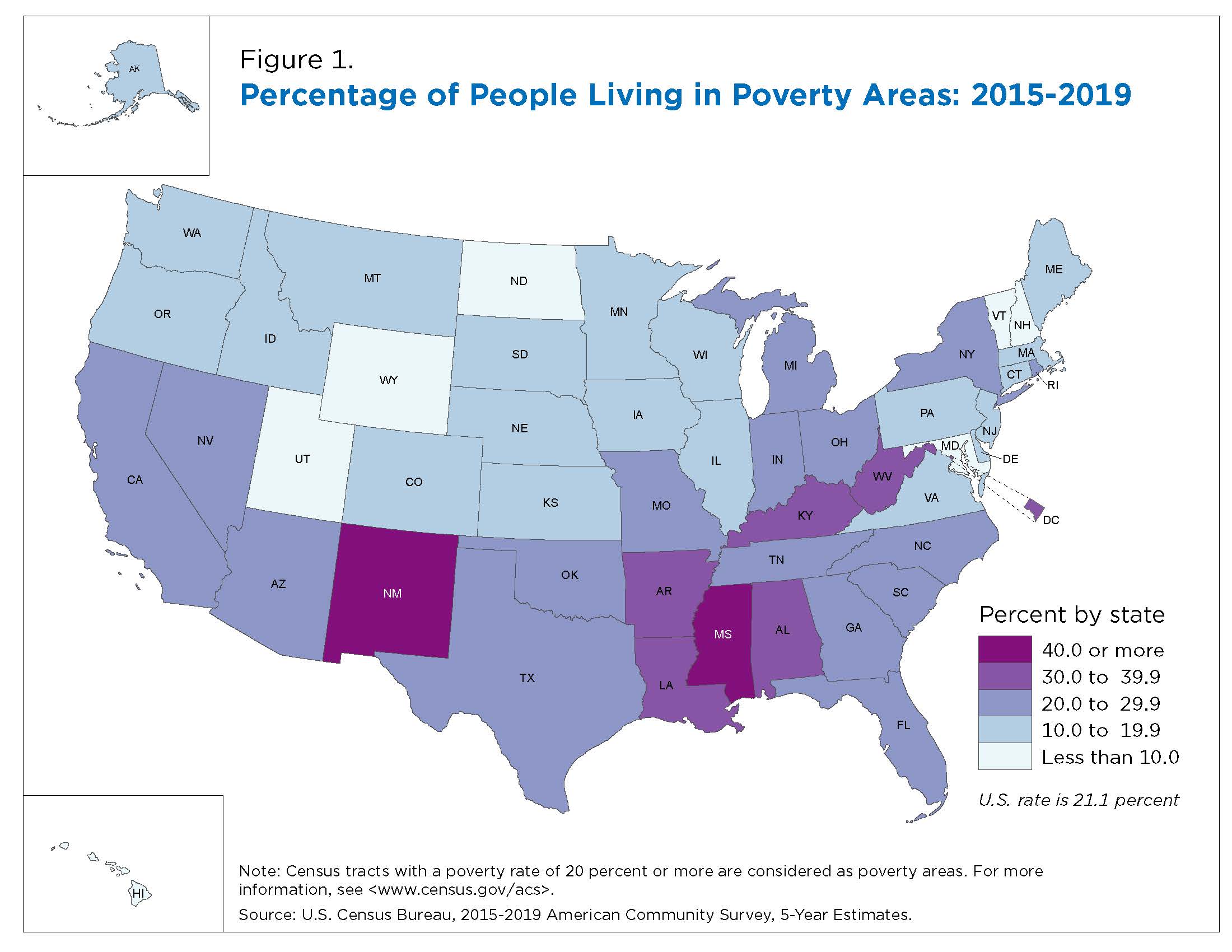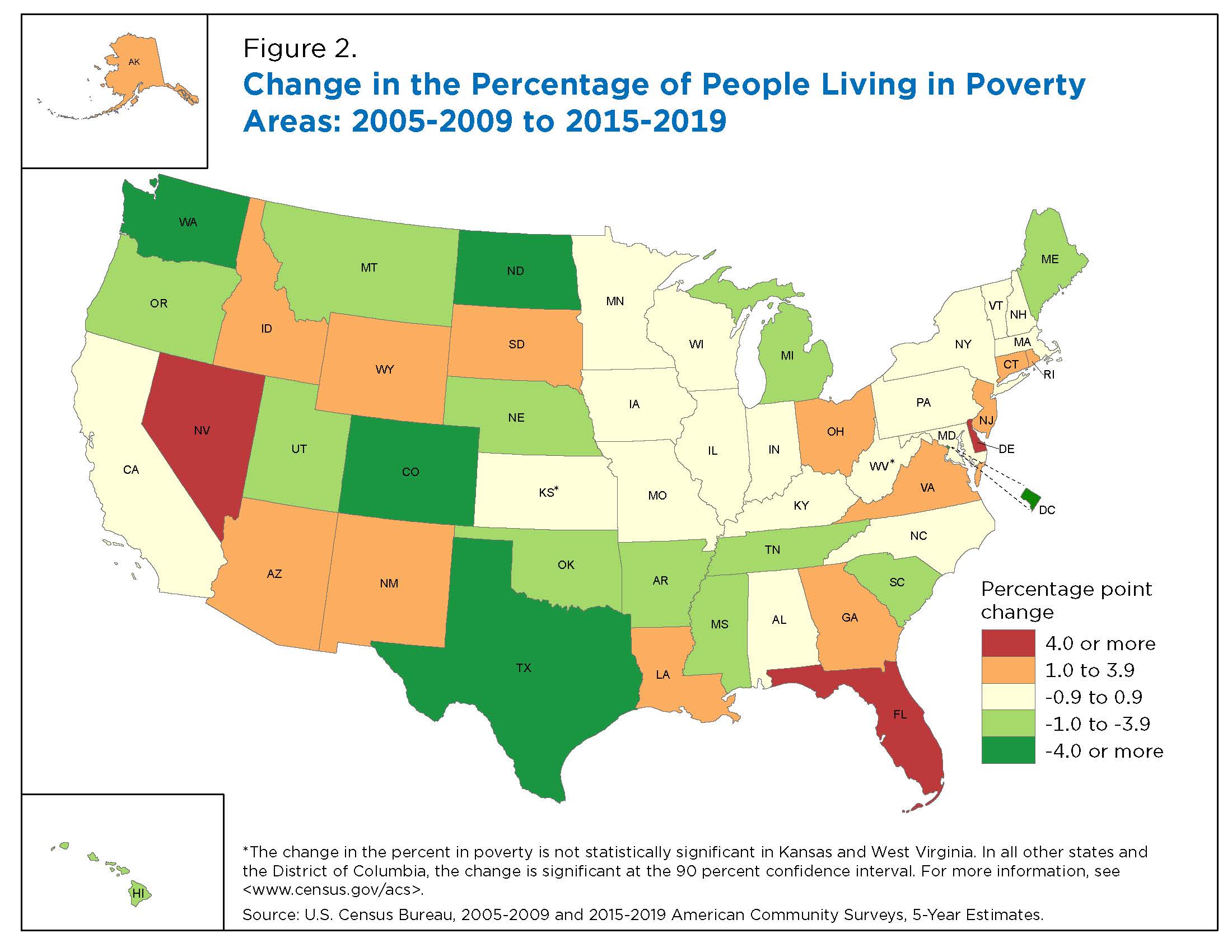Share of People Living in Poverty Areas Fell by 6.6 Percentage Points Since First Half of the Decade
The share of the U.S. population living in poverty areas declined in the second half of this decade, dropping below levels a decade earlier, according to recent data.
The U.S. Census Bureau’s 2015-2019 5-year American Community Survey (ACS) shows the percentage of people in the United States living in poverty areas – defined as census tracts where at least 20% of the population lives in poverty – increased between 2005-2009 and 2010-2014. It then decreased in 2015-2019 to a lower level than in 2005-2009.
These changes reflect the broader economic trends of the last decade.
Living in communities with high poverty concentrations exposes residents to several challenges, such as poor housing conditions, limited job opportunities and high crime rates.
The data cover a 15-year period that included both the Great Recession (December 2007 to June 2009) and the subsequent period of economic expansion. Data collection for the 2015-2019 ACS concluded in December 2019, before the COVID-19 pandemic.
Living in communities with high poverty concentrations exposes residents to several challenges, such as poor housing conditions, limited job opportunities and high crime rates. Government programs often target resources to these high-poverty neighborhoods.
Poverty Areas by State and Region
Figure 1 shows the percentage of people living in poverty areas varied in the states with some sharp regional differences.
The Census Bureau defines four regions: Northeast, South, Midwest and West. Six of the seven states with over 30% of their population living in poverty areas were in the South region.
In the 2015-2019 period:
- 21.1% of the U.S. population lived in poverty areas, ranging from a low of 5.2% in New Hampshire to a high of 42.4% in Mississippi.
- In seven states, all in the South except for New Mexico, and the District of Columbia, at least 30% of residents lived in high poverty areas. In Mississippi and New Mexico, at least 40% of people lived in high-poverty areas.
- In seven states, 10% or less of the population lived in poverty areas. These states were spread across the country: three in the West, two in the Northeast, one in the South and one in the Midwest.

The percentage of the U.S. population living in poverty areas changed during the 15-year period stretching from 2005 to 2019.
In the 2005-2009 period, 21.3% of the nation’s population lived in poverty areas. During the 2010-2014 period, this increased by 6.4 percentage points to 27.7%. The rate then declined by 6.6 percentage points to 21.1% in the 2015-2019 period.
From 2005-2009 to 2015-2019, the percentage of people living in poverty areas in the United States fell by 0.2 percentage points. But there was more variation between these two time periods at the state level (Figure 2).
From 2005-2009 to 2015-2019:
- The percentage of people living in poverty areas increased in 25 states and decreased in 23 states and the District of Columbia. The change was not statistically significant in two states.
- In three states — Nevada, Delaware and Florida —the percentage of the population living in poverty areas rose by more than four percentage points.
- In four states (Washington, North Dakota, Colorado and Texas), the slice of the population living in poverty areas dropped by four percentage points or more.

The report, Changes in Poverty Rates and Poverty Areas Over Time: 2005 to 2019, provides more information on changes in poverty areas in the United States. Percentage of People in Poverty by County: 2015-2019 is an interactive visualization that shows changes in county level poverty rates by Hispanic origin and race.
Em Shrider and Craig Benson are survey statisticians in the Poverty Statistics Branch.
-
Stats for StoriesNational Family Week: November 19-25, 2023In 2022, there were 83.3 million families in the U.S. and average family size had shrunk to 3.11 from 3.20 in 2007, according to the American Community Survey.
-
Stats for StoriesHomeless Persons’ Memorial Day: December 21, 2023HUD reports that on a single night in 2023, roughly 653,100 people in the U.S. experienced homelessness, up about 12 percent from 2022.
Subscribe
Our email newsletter is sent out on the day we publish a story. Get an alert directly in your inbox to read, share and blog about our newest stories.
Contact our Public Information Office for media inquiries or interviews.
-
America Counts StoryPoverty Rates for Blacks and Hispanics Reached Historic Lows in 2019September 15, 2020Black and Hispanic poverty rates reached historic lows of 18.8% and 15.7% respectively in 2019 but inequalities persist.
-
America Counts StoryChildren in Poverty Less Likely to Engage in Sports, Gifted ProgramsSeptember 23, 2020New U.S. Census Bureau survey highlights the impact that poverty has on school-aged children’s involvement in extracurricular activities.
-
America Counts StoryPayday, Poverty, and WomenSeptember 10, 2019Between 2017 and 2018, women working full-time, year-round experienced a significant gain in median earnings but more women than men live in poverty.
-
EmploymentU.S. Workforce is Aging, Especially in Some FirmsDecember 02, 2025Firms in sectors like utilities and manufacturing and states like Maine are more likely to have a high share of workers over age 55.
-
PopulationTribal Casinos: An Economic BoonNovember 20, 2025A new study explores how tribal casino expansion in the 1990s and 2000s affected poverty, jobs and income for American Indian communities and their neighbors.
-
NAICS Sector 31-33 ManufacturingSome Less Populous States Have High Manufacturing Revenue Per CapitaSeptember 29, 2025Today is the start of a week of celebrations at the Census Bureau marking the 14th annual Manufacturing Day on October 3.
-
Families and Living ArrangementsCouples’ Finances: Married but SeparateSeptember 24, 2025While most married couples had joint bank accounts, fewer shared all their financial accounts.




